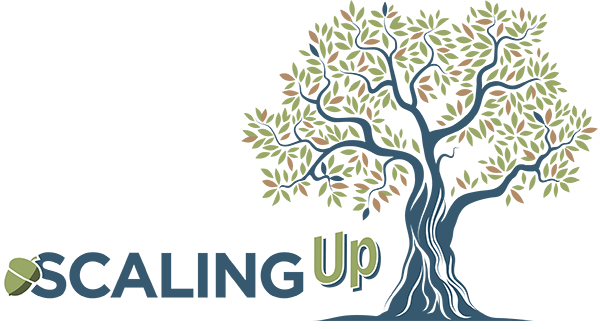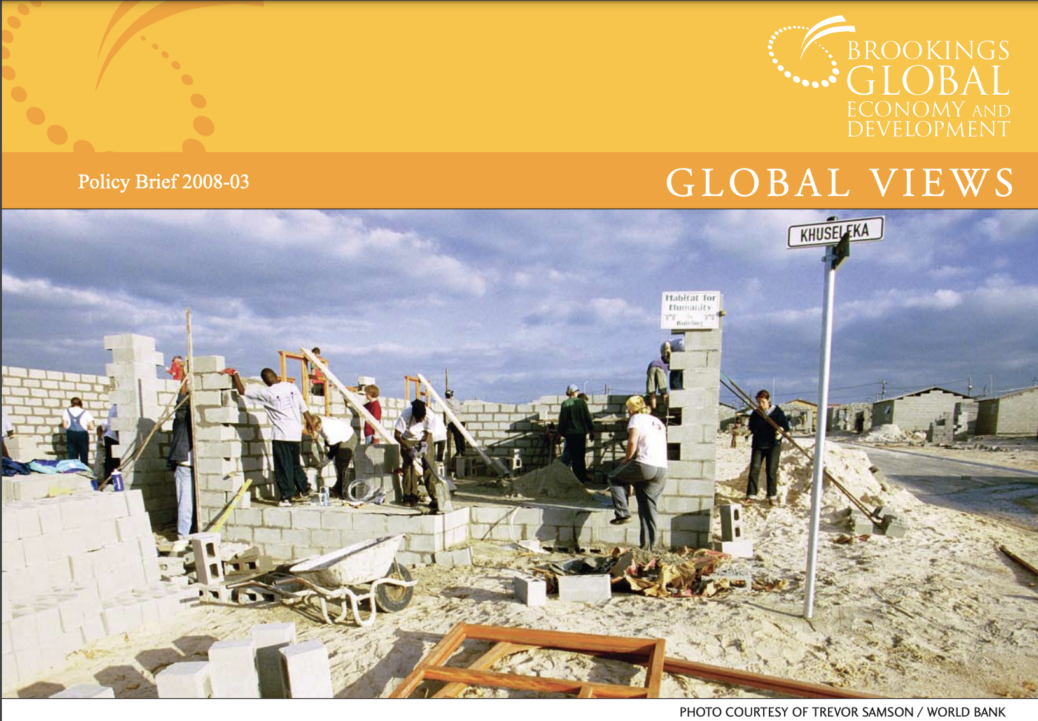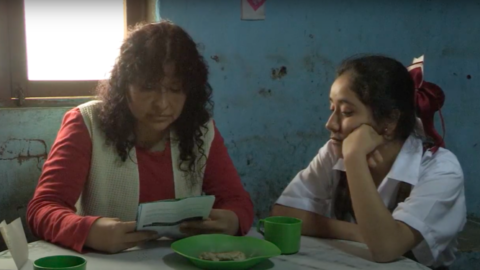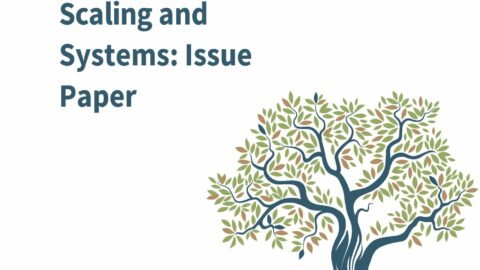Summary
At the Gleneagles Summit in 2005, leaders of the G8 group of nations committed to increase aid to poor nations by $50 billion per year. During the same year, in a meeting in Paris, donors promised to coordinate their interventions for more effective delivery. Th ese commitments are now often referred to as the promise of donors to “scale up aid.” Increasing aid flows and improving coordination are indeed important goals and, in fact, goals that donors seem to have trouble meeting. Th e international donor community met this fall in Accra and will meet in Doha in November 2008 to review progress with this aspect of scaling up aid, and it is hoped that they will recommit to meet the ambitious targets set three years ago.
Scaling up aid is only one of the challenges that donors face. A more important challenge is to “scale up through aid,” meaning that aid fl ows should not merely support short-lived, one-time and partial development interventions—pilot projects, short-term technical assistance, programs that only address part of the problem, but leave major bottlenecks unaddressed—but should support projects, programs and policies that scale up successful interventions in a country, region or globally to reach the entire target population. Scaling up means that programs are long-term and sustained and that external support is aligned with country needs and deals comprehensively with the development challenges—often by working in partnership with other donors and pooling resources. Th is is the scaling up challenge that donors should address head-on, but so far have not.
This policy brief reports on the findings of an in-depth review of the literature and practice of scaling up development interventions and focuses on the role that aid donors can play in supporting scaling up for effective development. It stresses that successful scaling up with external assistance means that donor agencies need to: work with a vision and leadership; help create the political constituencies for large-scale implementation; create linkages among project, program and policy interventions; strengthen the institutional capacity of the implementing entities; provide for effective incentives and accountabilities of their own staff and management; work together with each other; monitor and evaluate the progress of programs with special attention to the scaling up dimension; and finally make sure they focus on effective preparation and flexible implementation of the scaling up process. While this is a long-term agenda, donors can take a few practical steps right away that will provide a basis for a more ambitious effort over time.
Scaling Up Through Aid
In 2000, the global community set itself the challenge of meeting the Millennium Development Goals (MDGs) by 2015 as a way to combat world poverty. In 2007, the halfway point, it became clear that many countries will not be able to meet the MDGs unless greater efforts are made. Confronted with this challenge, the development community has committed to scale up development aid with a focus on how to mobilize, deploy and absorb the substantially increased levels of official development assistance promised at recent G8 summits. Fragmented aid architecture complicates this task. Multilateral, bilateral, and private aid entities have multiplied, leading to many more, but smaller, aid projects and programs and increasing transaction costs for recipient countries. Volatility in aid fl ows further compounds the problem of aid effectiveness. In response, official donors committed themselves in the “Paris Declaration” to work together for more efficient and better coordinated aid delivery.
However, the real challenge is not just how to deliver more, better coordinated and less volatile aid. A key constraint is that development interventions—projects, programs, policies—are limited in scale and short-lived and therefore without lasting impact. Th is may explain why so many studies have found that external aid has had only weak or no development impact at a global and country level, even though many individual interventions have been successful in terms of their project- or program-specific goals. In order to reduce poverty, we have to follow the advice of James Wolfensohn and discover “how to move from our feel-good successes to large scale, how to scale up these initiatives to a depth and breadth where we can really have an impact on poverty, where we can achieve the Millennium Development Goals.” In this context, scaling up means not simply more aid, but aid that expands, adapts, and sustains successful projects, programs, or policies over time for greater development impact.
In fact, this particular focus on scaling up is not new. In the 1970s and 1980s, the World Bank under President McNamara pursued an active scaling up agenda. In the early 2000s, President Wolfensohn of the World Bank revived his institution’s focus on scaling up, but this agenda was promptly abandoned by his successor. During the 1980s, scaling up began to be seen also as a challenge for nongovernmental organizations (NGOs) as their engagement in development increased, especially in connection with participatory and community development approaches. Today, there is again a growing interest among some philanthropic foundations and NGOs in how to scale up their interventions.
Given the urgency of the development agenda and the renewed interest in scaling up, we decided to take a comprehensive look at what the literature and practice tell us about whether and how to scale up development interventions. Based on this in-depth review, we summarize in this policy brief the key lessons and consider aid’s special role in the scaling up process. We end with some practical recommendations for aid agencies to ensure that they eff ectively pursue a scaling up agenda.
Whether to Scale Up
The first question to ask is whether a project, program or policy should be scaled up, and if so, how far and for how long. A decision to scale up a program requires a reflection on the optimal size of programs. Should the program operate on a national, a provincial or a local level? Diseconomies of scale, quality/ Scaling Up Through Aid Whether to Scale Up 4 scale trade-off s and institutional constraints might put limits to the scaling up path. Scaling up, thus, does not necessarily mean nation-wide coverage. On the other hand, to be effective, some programs need to be expanded supra-nationally to a regional scale. Th is is typically the case for regional infrastructure, water, energy and environmental programs, especially for the small countries in Africa, Central America, Central Asia and South-East Europe. Some interventions must operate at a global scale, such as programs to combat global epidemics (HIV/AIDS) or global environmental threats (global warming).
Scaled up interventions should not always last indefinitely. For example, privatization as a process and the institutional infrastructure needed has a limit both in terms of extent (how much to privatize) and in terms of duration: Once all requisite fi rms and assets have been privatized, the privatization process and institution need to be wound down. Scale limits and sunset provisions are especially important in areas where public action is taken to correct, for what are at best seen as, temporary private market failures—state banks, state marketing boards, etc. In these cases, the critical issue is how to ensure an effective enabling environment for private initiatives rather than concern over large scale and long-term public interventions.
How to Scale Up
Scaling up takes time—often ten to fifteen years, or more. Th is long time horizon poses great challenges: donors shift priorities, governments change, NGO funding is driven by fashion, agency managers and staff move on. Th e long time horizon requires that scaling up needs to be perceived as a systemic effort, not as a short-term fad. Experiences with successful scaling up programs have shown the importance of long-term commitment of institutions, donors and individuals. At the same time, programs have to be designed in such a way that they survive government changes. Th is requires a systematic strategy for how to scale up a basic set of institutional values and incentives, which ensure that key actors are continuously searching for ways to build on successful interventions to see that they are replicated, expanded, transferred to and adapted in other settings.
There are three building blocks for how such scaling-up strategies can be designed or how basic values and incentives can be instilled. Scaling up requires vision, drivers and space in which to grow.
Vision
Ideally, vision for scaling up should be developed while the fi rst phase of a program, or pilot, is being put in place. Pilots should be designed in such a way that they could be scaled up, if successful. Far too frequently, donors and governments design operations as one-time interventions. Projects that are “expensive boutiques” with high unit cost and high management and human skill intensity may do well on a limited scale, but they generally cannot be replicated. Th e question whether scaling up is appropriate should be explicitly factored into the decision whether and how to implement the intervention in the fi rst place. A good example for a clear vision about the appropriate scale of intervention is the ProgresaOportunidades program in Mexico that, although starting with a pilot phase, aimed from the beginning to provide conditional cash transfers to all of Mexico’s poor.
How to Scale Up
Drivers Scaling up is a dynamic process that needs drivers to push it forward. Ideas and innovations that stimulate and meet peoples’ needs and demands are essential for any process of social change and for scaling up in particular. But the process also needs leadership. It needs a champion. All successful programs taken from small to large scale have benefited from charismatic leaders endowed with a vision, persistent in their efforts, often well connected to major stakeholders and constituencies, with the ability to build up authority and guide people. Th e innovative idea that microcredit can help poor entrepreneurs was propelled by the vision and leadership of Muhammad Yunus and Fazle Hasan Abed to achieve the scale and impact of the Grameen Bank and of BRAC, respectively. Th e notion that an NGO can combat global corruption required the leadership of Peter Eigen when he created Transparency International. Finally, external catalysts—crises, such as natural disasters or economic meltdowns—or the influence of outside actors can serve as drivers of change and scaling up. In Central and South-East Europe, the prospect of accession to the European Union has been a driver of sustained change, reform and scaling up for over a decade.
Space to Grow
But vision and drivers are not enough. For interventions to be scaled up, they need space in which to grow. Sometimes, such space is readily available, but more often than not the space has to be created. Scaled up programs require:
- Fiscal and financial space to support the inevitably higher expenditures, even if unit costs drop at higher scale—which is not guaranteed;
- Political space since supportive constituencies need to be mobilized and political opposition needs to be neutralized;
- Policy space by ensuring that potential policy obstacles are identified and removed;
- Institutional space with institutions willing or able to create and operate the larger program; this in turn requires adequate manpower, skills and processes to manage the enlarged program and incentives to overcome typical bureaucratic inertia;
- Cultural space to ensure that programs working in one community also fi t culturally in others;
- Partnership space that allows external and internal partners to support a program with financial, technical and political resources; and
- Learning space in which monitoring and evaluation feedback ensures that programs, as they grow, are adjusted based on the lessons learned.
Implications for Aid and Aid Agencies
Donors have a particular role to play in the scaling up process. Especially in many of the poor and aid dependent countries, this process involves a complex relationship between donor and recipient agencies. Th is relationship tends to be one-sided, in the sense that recipients depend on the donors and need to follow donors’ preferences. Because of this unequal relationship, donors carry a special responsibility for the scaling up effort.
There are examples of close partnerships between local public agencies or NGOs and external donor partners in successful scaling up experiences, including the River Blindness Eradication Program in West Africa, the Loess Plateau Watershed Rehabilitation Project in China, the Russia coal sector reform program, multi-decade support for irrigation development in Thailand, and regional cooperation initiatives, such as the Great Mekong Sub-region Program and the Central Asia Regional Economic Cooperation Program.
An important platform through which the scaling up agenda could be moved forward is the “Paris Declaration.” Adopted in 2005, it commits offi cial aid agencies and recipient governments to the following fi ve basic tenets: (i) government ownership of development programs; (ii) alignment of donor processes with government systems; (iii) harmonization among development partners and with government; (iv) managing for results; and (v) mutual accountability of donors and government.
Progress in implementing this agenda unfortunately has been mixed, and some donors, in particular the US, do not exhibit a strong commitment to the Paris Declaration. If implemented, harmonization of programs could help to take successful smaller interventions to bigger scale. Donor alignment with government systems and government ownership as the eminent principle for interventions should help to create the policy space, the fiscal/financial space and the political space for successful programs to grow. In addition, bilateral and multilateral donors increasingly rely on joint donor financing instruments, such as sector-based lending, basket lending, sector and general budgetary support instruments—all of which also can support the scaling up of programs. However, more could be done. Unfortunately, there was no explicit mention made of scaling up in the Communiqué of the Accra High Level Forum for the Paris Declaration held in September 2008, but an explicit inclusion of the scaling up agenda into the Paris Declaration would provide an important step forward.
Some donor agencies have introduced the idea of “scaling up” into their strategic rhetoric and are attempting to institutionalize scaling up. UNICEF, for example, lists its fi rst priority for HIV/AIDS education “to move away from small scale pilot projects” and “expand effective and promising approaches to national scale.” IFAD defines its mission among other aspects by the catalytic role that it hopes to play through supporting innovation and its rollout. Th e World Bank, under James Wolfensohn, co-sponsored with the Chinese Government a major learning exercise and conference in Shanghai on scaling up, and the Bank’s Rural Development Strategy states that scaling up good practices must become an integral part of national rural development strategies. Sadaka Ogata, the head of Japan’s newly consolidated aid agency JICA, recently stated that her institution will aim to “speed up, scale up and spread out” the impact of its assistance.
But a quick check of principal donors’ Web sites shows that these are the exceptions rather than the rule. Moreover, it appears that there is little systematic focus on scaling up among the donor agencies, despite the fact that there are some good project and program examples for scaled-up impact, that instrumentalities for scaling up are available and that some individual institutions occasional stress scaling up as a goal.
This leads us to the conclusion that the donor community needs a change of mindset and practices. First and foremost, defining a clear vision, applying strong leadership and instilling the institutional values in the aid agency to assure that the scaling up goal is systematically reflected in the institutional mission and practices is necessary.
Second, aid agencies need to see the creation of “political space” as an important aspect of the programs they fi nance, as scaling up can only take place with political support. Stakeholder analysis, information campaigns, outreach to constituencies and efforts to assist those negatively affected by programs are all elements of a strategy that reflects consideration of the political space in which scaling up needs to take place.
Third, linking support for projects, programs and policies in a seamless web is important—the World Bank has been most advanced in this regard, but other donors could and should do more.
Fourth, helping to build the institutional capacity for scaling up is critical. Special efforts must be made to avoid setting up parallel institutions for aid-financed projects, such as the still frequently used “Project Implementation Units.” Th e common focus of aid agencies on capacity building is welcome, but it needs to go beyond conventional training, twinning and expert advice, in assuring that local expertise is actually created and sustained, through long-term support for learning-by-doing, and by stressing reform of institutional incentives and accountabilities to assure there is actually a demand for the capacity to be created at the country level.
Fifth, donors must realign their own institutional incentives and accountabilities to assure that staff and mangers, strategies and programs, as well as technical advice and financing, are directed to the scaling up objective.
Sixth, donors need to get serious about harmonizing their administrative and fiduciary requirements. This is an area in which the Paris Declaration was to make progress, but little seems to have been achieved so far. The successful eff ort by BRAC to get its donors to pool their resources and harmonize their disbursement and reporting requirements is an example of what can be done.
Seventh, donors have to overhaul their evaluation approaches. Currently donor agencies only evaluate project impact and sustainability, but not whether projects have provided the basis for scaling up and whether successful projects and programs were actually replicated and scaled up.
Finally, support for a gradual, orderly and coordinated process in which other partners are brought to the table, systematic learning can take place, simple solutions for scaling up can be identified and applied, and sustained financial support is provided, should become the norm, rather than the exception.
Immediate Steps to Make Scaling Up Aid a Reality
Donors could take some immediate practical steps to implement these broad priorities:
- The Paris Declaration should be broadened to include scaling up as an explicit component.
- Each agency should implement a “scaling up audit” with independent outside input. This audit would assess how far the agency focuses on scaling up and what changes are needed to induce more systematic and effective scaling up efforts. Project preparation manuals and operational policies should be amended to reflect the need for scaling up. Country and sector strategies as well as project documents should address scaling up explicitly.
- The donor agencies’ evaluation units should review their evaluation approaches and manuals and ensure that they adequately address scaling up. The newly established International Initiative for Impact Evaluation (3IE) should address this issue and thus ensure a concerted donor effort.
- Donors individually or collectively should set up “replication funds;” these funds would provide financing, possibly on concessional terms and in the form of matching grants or loans, as an incentive for scaling up successful programs. This could be linked with “development market place” initiatives that would reward not only innovative projects, but also the replication of well-evaluated successful projects.
- Donors should expand the use of programmatic instruments that allow for going from individual projects to support for broader sector programs. Th ese can be multi-donor sector wide approaches (SWAPs) to pool donor resources for sectoral programs; or single-donor support for multi-jurisdictional initiatives, which use a competitive or tournament approach to provide incentives and finance to multiple jurisdiction at the same time.
- Stakeholder analysis, political analysis, citizens’ report cards and client surveys should be introduced as routine instruments for country strategies and project appraisal.
- Donor agencies should create a network of senior managers, recipient country representatives and technical experts who regularly meet to explore how scaling up initiatives can be supported across donor institutions.
- Donors should support systematic research on scaling up. Evaluations of donor-financed research programs should not only assess the academic quality of the research output, but also its policy and operational relevance, as well as what efforts are being made to disseminate the research effectively for operational application.





